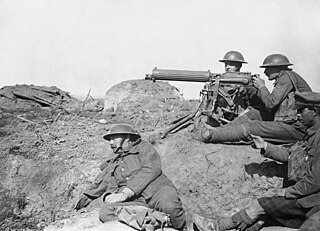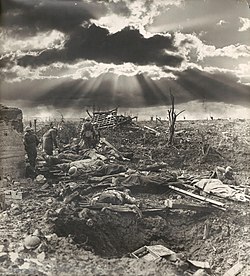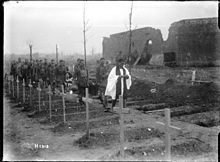
The Third Battle of Ypres, also known as the Battle of Passchendaele, was a campaign of the First World War, fought by the Allies against the German Empire. The battle took place on the Western Front, from July to November 1917, for control of the ridges south and east of the Belgian city of Ypres in West Flanders, as part of a strategy decided by the Allies at conferences in November 1916 and May 1917. Passchendaele lies on the last ridge east of Ypres, 5 mi (8 km) from Roulers, a junction of the Bruges-(Brugge)-to-Kortrijk railway. The station at Roulers was on the main supply route of the German 4th Army. Once Passchendaele Ridge had been captured, the Allied advance was to continue to a line from Thourout to Couckelaere (Koekelare).

The New Zealand Division was an infantry division of the New Zealand Expeditionary Force raised for service in the First World War. It was formed in Egypt in early 1916 when the New Zealand and Australian Division was renamed after the detachment of its Australian personnel left the New Zealand Infantry Brigade, together with reinforcements from New Zealand, as the basis of the division. It was commanded by Major General Andrew Hamilton Russell for the duration of the war.

The Battle of Messines was an attack by the British Second Army, on the Western Front, near the village of Messines in West Flanders, Belgium, during the First World War. The Nivelle Offensive in April and May had failed to achieve its more grandiose aims, had led to the demoralisation of French troops and confounded the Anglo-French strategy for 1917. The attack forced the Germans to move reserves to Flanders from the Arras and Aisne fronts, relieving pressure on the French.

The Battle of Poelcappelle was fought in Flanders, Belgium, on 9 October 1917 by the British Second Army and Fifth Army against the German 4th Army, during the First World War. The battle marked the end of the string of highly successful British attacks in late September and early October, during the Third Battle of Ypres. Only the supporting attack in the north achieved a substantial advance. On the main front, the German defences withstood the limited amount of artillery fire achieved by the British after the attack of 4 October. The ground along the main ridges had been severely damaged by shelling and rapidly deteriorated in the rains, which began again on 3 October, turning some areas back into swamps.

The Battle of Broodseinde was fought on 4 October 1917 near Ypres in Belgium, at the east end of the Gheluvelt plateau, by the British Second and Fifth armies against the German 4th Army. The battle was the most successful Allied attack of the Third Battle of Ypres. Using bite-and-hold tactics, with objectives limited to what could be held against German counter-attacks, the British devastated the German defence, which prompted a crisis among the German commanders and caused a severe loss of morale in the 4th Army. Preparations were made by the Germans for local withdrawals and planning began for a greater withdrawal, which would entail the abandonment by the Germans of the Belgian coast, one of the strategic aims of the Flanders offensive.

The Battle of Polygon Wood took place from 26 September to 3 October 1917, during the second phase of the Third Battle of Ypres in the First World War. The battle was fought near Ypres in Belgium, in the area from the Menin road to Polygon Wood and thence north, to the area beyond St Julien. Much of the woodland had been destroyed by the huge quantity of shellfire from both sides since 16 July and the area had changed hands several times.

The Battle of Langemarck was the second Anglo-French general attack of the Third Battle of Ypres, during the First World War. The battle took place near Ypres in Belgian Flanders, on the Western Front against the German 4th Army. The French First Army had a big success on the northern flank from Bixschoote to Drie Grachten and the British gained a substantial amount of ground northwards from Langemark to the boundary with the French.

The Second Battle of Passchendaele was the culminating attack during the Third Battle of Ypres of the First World War. The battle took place in the Ypres Salient area of the Western Front, in and around the Belgian village of Passchendaele, between 26 October and 10 November 1917. The Canadian Corps relieved the exhausted II Anzac Corps, continuing the advance started with the First Battle of Passchendaele and ultimately capturing the village. Beyond gaining favourable observation positions, the battle was intended to gain drier winter positions on higher ground.

The Battle of Pilckem Ridge was the opening attack of the Third Battle of Ypres in the First World War. The British Fifth Army, supported by the Second Army on the southern flank and the French 1reArmée on the northern flank, attacked the German 4th Army, which defended the Western Front from Lille northwards to the Ypres Salient in Belgium and on to the North Sea coast. On 31 July, the Anglo-French armies captured Pilckem Ridge and areas on either side, the French attack being a great success. After several weeks of changeable weather, heavy rain fell during the afternoon of 31 July.

The Battle of the Menin Road Ridge, sometimes called "Battle of the Menin Road", was the third British general attack of the Third Battle of Ypres in the First World War. The battle took place from 20 to 25 September 1917, in the Ypres Salient in Belgium on the Western Front. During the pause in British and French general attacks from late August to 20 September, the British changed some infantry tactics, adopting the leap-frog method of advance.

The Capture of Wurst Farm was an attack by the British 58th Division against the German 36th Division on 20 September 1917, near Ypres, Belgium, during the Battle of the Menin Road Ridge, part of the Third Battle of Ypres. Wurst Farm was at the lower end of Gravenstafel Ridge and several British attacks in the area since 31 July had been repulsed by the Germans. The British began a desultory bombardment on 31 August and the shelling became intense from 13 September, to "soften" the German defences, except in the area of the Fifth Army, where the slow bombardment continued until 24 hours before zero hour, when a surprise hurricane bombardment was to be fired.

The action of 25 September 1917 was a German methodical counter-attack (Gegenangriff) which took place during the Third Battle of Ypres (31 July – 10 November) on the Western Front during the First World War. On the front of the British X Corps at the south-east side of the Gheluvelt Plateau, two regiments of the German 50th Reserve Division attacked on both sides of the Reutelbeek stream, on a 1,800 yd (1,600 m) front. The Gegenangriff was supported by German aircraft and 44 field and 20 heavy batteries of artillery, four times the usual amount of artillery for a German division.

The Actions of 30 September – 4 October 1917 were German methodical counter-attacks during the Third Battle of Ypres, in Flanders, during the First World War. Hasty counter-attacks by the German 4th Army during the Battle of the Menin Road Ridge on 20 September and the Battle of Polygon Wood on 26 September, had been costly failures. On 29 September, a review was held at Roulers by Erich Ludendorff, the Generalquartiermeister with the commanders of Heeresgruppe Kronprinz Rupprecht von Bayern and the 4th Army staffs.

The Gheluvelt Plateau actions, July–August 1917 took place from 31 July to 27 August, during the Third Battle of Ypres in Belgium, in the First World War. The British Fifth Army and the German 4th Army fought for possession of the plateau at the highest part of the ridges to the south-east, east and north-east of Ypres in West Flanders. The 4th Army had been building defensive positions in the Ypres Salient since 1915 and the Gheluvelt Plateau was the most fortified section of the front. The Fifth Army had made the plateau its main objective during the Battle of Pilckem Ridge but the II Corps advance was contained short of its objectives and German counter-attacks later recaptured some ground.

The Capture of Westhoek took place on the Gheluvelt Plateau near Ypres in Belgium, during the Third Battle of Ypres, in the First World War. The British Fifth Army attacked the Gheluvelt Plateau at the Battle of Pilckem Ridge but the German 4th Army had fortified its positions in the Ypres Salient since the Second Battle of Ypres. The British reached the first objective in the south and the second objective on the northern flank, losing some ground to German counter-attacks. A British attack due on 2 August was postponed because torrential rains from the afternoon of 31 July until 5 August washed out the battlefield.

The Action on the Polderhoek Spur, was a local operation in the Ypres Salient, by the British Fourth Army against the German 4th Army during the Third Battle of Ypres in Belgium during the First World War. Two battalions of the 2nd New Zealand Brigade of the New Zealand Division attacked the low ridge from which German observers could view the ground from Cameron Covert to the north and the Menin road to the south-west. A New Zealand advance of 600 yd (550 m) on a 400 yd (370 m) front, would shield the area north of the Reutelbeek stream from German observers on the Gheluvelt spur further south.

The action of 22 October 1917 was an attack during the Third Battle of Ypres in the First World War by the British Fifth Army and the French First Army against the German 4th Army. British attacks had been repulsed at Passchendaele by the 4th Army at the Battle of Poelcappelle and the First Battle of Passchendaele. While the British waited for another dry spell and the completion of plank roads up to the new front line, the Canadian Corps and fresh British divisions were transferred to Flanders by the British Expeditionary Force (BEF).

The Night action of 1/2 December 1917 during the First World War, was a local operation on the Western Front, in Belgium at the Ypres Salient. The action was a British Fourth Army attack on the German 4th Army. The Third Battle of Ypres proper had ended officially on 20 November but the attack was intended to capture the heads of valleys leading eastwards from the ridge, to gain observation over German positions.

The action of the Cockcroft took place on 19 August 1917, during the Third Battle of Ypres on the Western Front in the First World War. At the Battle of Langemarck the infantry of the 48th Division and the 11th (Northern) Division of XVIII Corps had been stopped well short of their objectives. The British had been shot down by the German garrisons of blockhouses and pillbox outposts of the Wilhelmstellung. At a conference called by General Hubert Gough, the Fifth Army commander, on 17 August, Gough and the corps commanders arranged for local attacks to be made at various points, to reach a good jumping-off line for another general attack on 25 August.

The action of 22 August 1917, took place during the First World War, in the Ypres Salient on the Western Front as part of the Third Battle of Ypres. The engagement was fought by the Fifth Army of the British Expeditionary Force and the German 4th Army. During the Battle of Langemarck, the British had advanced north of the village but had been defeated further south and failed to capture the Wilhelmstellung, the third German defensive position. At a conference with the Fifth Army corps commanders on 17 August, Gough arranged for local attacks to gain jumping-off positions for another general attack on 25 August. At the action of the Cockcroft on 19 August, XVIII Corps and the 1st Tank Brigade had captured five fortified farms and strongpoints for a fraction of the casualties of a conventional attack.
























